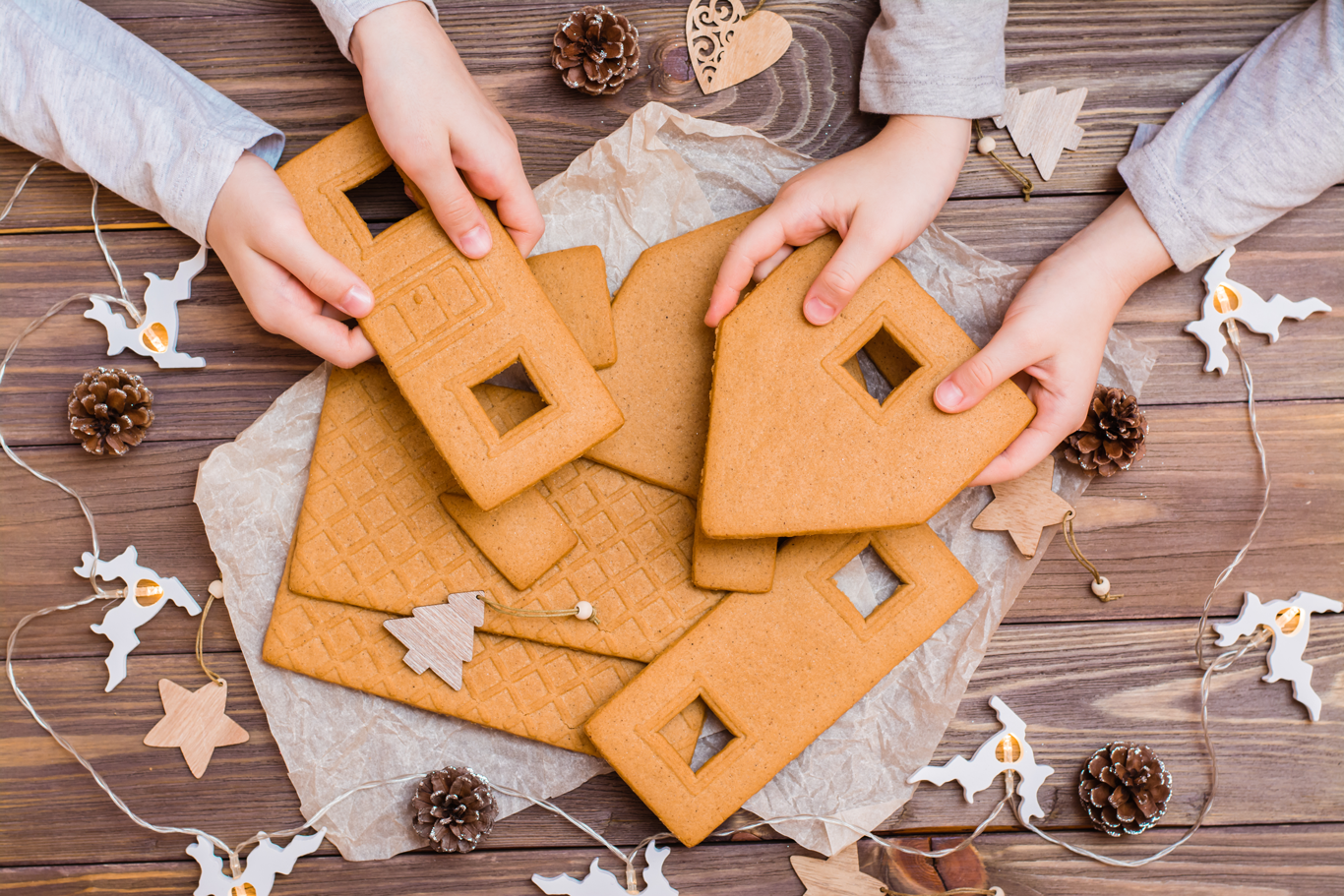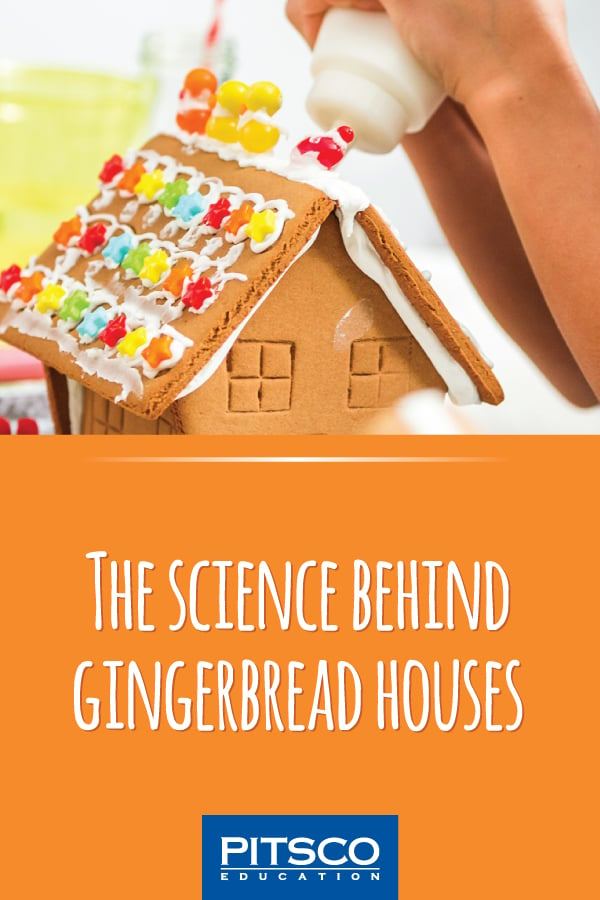Updated 6/11/24
Have you ever built a gingerbread house? This traditional holiday activity is as popular and fun as it is frustrating. From the graham cracker, no-baking-required creations to store-bought kit houses to the work of art at our nation’s capital, it takes art, science, and some magic to bring them to life. Yes, even, the White House celebrates the season with a gingerbread house!
Fun fact: The White House’s official pastry chefs have created a gingerbread house for each administration each season for the last 50 years. From the very first Nixon A-frame to the “Spirit of America” display, the merriment is always a special part of the annual decorations.
While you might not have the chef skills to achieve a White House-level masterpiece, with the help of some STEM, yours can still be awesome and just as memorable.
The Basics of Gingerbread
UCLA’s Science and Food blog took a deep dive into the science behind both gingerbread and the icing. They say, “Gingerbread should be sturdy and demonstrate elasticity . . . . Because the gingerbread walls will be under stress from the roof, there needs to be sufficient resistance to avoid cracking or total collapse. Dough with a tough, springy consistency and decreased moisture content is ideal, and can be achieved by using flour with high protein content, such as bread flour. Higher-protein flours contain more glutenin and gliadin proteins, which create the springy gluten network that gives dough its elastic properties.”
Sally’s Baking Addiction maintains that the recipe for success is to use:
- A small amount of baking soda for less puff.
- Less butter so the house shapes are harder.
- Less molasses so the dough isn’t as sticky.
- Add water to make a smoother dough.

Popular Science and Serious Eats say you need structural or construction gingerbread. This means your recipe won’t have any leavening agents (i.e., baking soda or baking powder) or eggs and that you’ll swap molasses for corn syrup, which ups the pliability – the give – to your structures out of the oven. They do give the caveat that this recipe is for building and not eating.
While each source has their own spin on the recipe, the basic premise is you want flat, sturdy gingerbread. By limiting or excluding leavening agents, your dough won’t rise, and if you limit or exclude water and eggs, the steam formation is limited. All of this yields that desired flatness.
And as for the icing, everyone agrees, royal icing is the way to go. This isn’t your standard decorator’s buttercream situation. The UCLA crew says, “Icing serves as the glue that holds the entire structure together. The mixture should be just pliable enough to hold the gingerbread pieces together before drying into a hard, unmovable substance. Here egg whites are key. When beaten, the egg’s proteins denature and then coagulate, stabilizing air bubbles in the icing and creating white, foamy ‘peaks’ that vary in their stiffness and resistance to gravity. Stiffer peaks are better for gingerbread icing, and more coagulated proteins can contribute to a stronger paste.”
Engineering a Festive Masterpiece
Learn from others! There are many tips and tricks for upping your gingerbread game from the planning to the baking to the building to the decorating.
- Martha Stewart has tons of creative (and no-bake) ideas for toppings and builds.
- The Spruce Eats has a step-by-step take on the process and some awesome decorating ideas.
- An undergraduate at Brown University recommends swapping royal icing for caramel, or melted marshmallows – that sounds pretty sweet to us.
Many of the recipes we’ve linked give you excellent step-by-step directions to help provide an easier experience and a great result. And, after you’ve got your structure ready, it’s time to let the spirit of the season take over. Cereal shingles, hard candy windows, chocolate candy lights, coconut snow, licorice guttering, mint sidewalks – the possibilities are endless!
Take Tradition to a New Level
The Pitsco Blog team wanted to try our hand at this tradition. In true Pitsco fashion, we wanted to make it an experiment. We decided to compare the building experience and sturdiness of homemade gingerbread construction materials versus a store-bought kit versus a graham cracker-based structure. Two teams built with hand-baked gingerbread, one with a kit, and one with graham crackers. We used this recipe for our homemade builds. Each had store bought royal icing and assorted candies and cereal.
We built them together so we each had the same amount of time to build, much like you would in a classroom (constraints). We worked in teams and shared materials (collaboration in action!). While building the houses was a lot of fun, we wanted to take it to another level by testing the integrity of our builds on a Pitsco EQs Tremor Table. So, after we built our houses, we let them dry for 24 hours. Then, one by one, we put our structures to the test.
Because these aren’t structures typically tested on the device, we didn’t use the foundation block and improvised with our mounting techniques – videography gaff tape and then large binder clips. This was factored into our testing and judging. We believe the tape provided a little more slop in testing and might have lost its stickiness after repeated use while the binder clips might have been closer to the anchored experience you would normally have with the device.
Check out this quick compilation of our testing experience.
We hypothesized offhandedly that the store-bought kit would be the most durable and easiest to build, possibly because of the standardized processes and preservatives. The kit we happened to get came totally prebuilt – talk about easy! But it was the only structure to finally break apart in testing.
The homemade gingerbread had some variance among the houses. We used two sections of homemade dough, one chilled and one closer to room temperature. We observed while rolling the chilled dough prior to baking that the temperature made it tough to roll smoothly and the end result was puffier because we had to work the dough more. The second disc of room temperature dough was smoother and held its shape and straight edges better. However, the variance didn’t result in any differences during testing.
Building with graham crackers was the most difficult. We did get it to stay upright eventually, but the grahams seemed more limiting. We’d recommend using some type of support (cardboard or milk carton) to help keep the structure in place while building. Though, to our surprise, it did do well in testing.
We had a blast and think this is totally repeatable in the classroom to varying degrees. But we want you to take our more informal experience and make it better. Here’s what we recommend when doing this holiday STEM activity in your classroom:
- Explain/highlight the engineering design process as it happens. This can certainly bring the EDP to life!
- Identify any constraints you want to require (time limit, materials, height of structure, and elements that must be used).
- Break the activity up over two to three days. Buffer with time for drying the structure before moving straight to decorating. And, don’t forget drying time before testing.
- Make sure to have students generate a hypothesis prior to testing.
- Create a rubric of criteria to test. For example, you could measure or observe the number of cycles endured, rate endured, and first point of weakness(es). You can also incorporate some creativity and arts by judging best use of materials, most creative, most realistic, and so on. While mostly subjective, they’re fun to consider.
- Allow for time to reflect and compare experiences either verbally, with multimedia (video or pictures), with a journal entry opportunity, or any combination of these.
- Consider making it a contest and giving prizes based on your rubric criteria. It’s fun for everyone, but a competition adds a little something extra to the mix.
- Definitely remember to not take it too seriously!

Extra Ideas, Extra Fun!
Several STEM activities, ideas, and resources are floating on the web for gingerbread. Gingerbread House Geometry: Edible STEM is one that caught our eye.
And if you’re looking for some inspiration for your future house designs, be sure to check these out:
- K-State President’s Gingerbread Home video
- Star Wars Bakery’s Giant Imperial Star Destroyer
- 55 Gingerbread House Ideas That’ll Inspire You to Make an Epic Masterpiece
- 17 Amazing Gingerbread Houses You Have to See to Believe
All in all, building a gingerbread house is a pretty sweet hands-on, minds-on activity. We’re confident it fosters some critical thinking, creativity, collaboration, communication, and even some (sugar) cravings. We can’t wait to hear more about your gingerbread experiments and experiences. Be sure to comment or tag us in your social posts if you give this holiday STEM idea a try.


